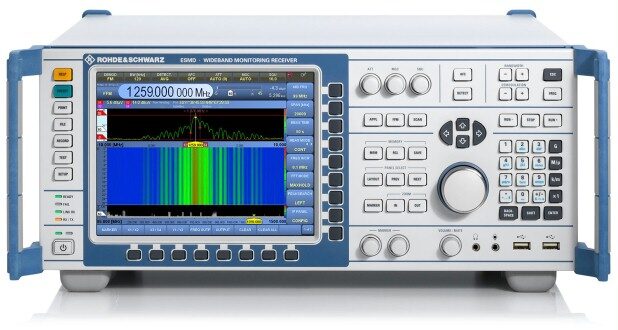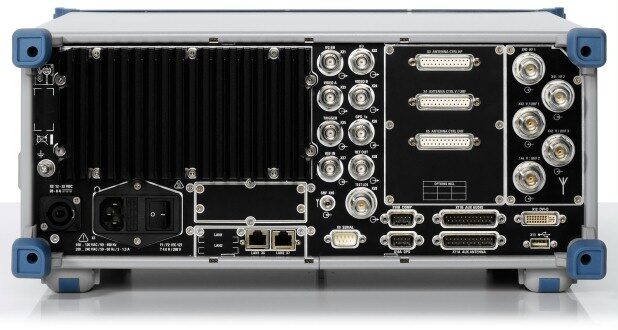Rohde & Schwarz ESMD Wideband Monitoring Receiver. Made in Germany.
Brief Description
The R&S®ESMD wideband monitoring receiver was specially developed to handle signal searching, radiomonitoring, radio detection and spectrum monitoring tasks. It performs all measurements in line with ITU recommendations and meets the requirements of security authorities and organizations. The receiver is ideal for both stationary and mobile/vehicular applications, because it can be controlled via the front panel or remotely via LAN.
Key Facts
- Performance of ITU-compliant measurements and public safety and security tasks
- Wide frequency range from 9 kHz to 26.5 GHz (base unit: 20 MHz to 3.6 GHz)
- 20 MHz realtime bandwidth (optionally 80 MHz)
- Numerous options to increase performance
- Various result displays
- Integration into customer-specific software packages from third-party suppliers thanks to open, documented, remote control interfaces and data formats
Features & Benefits
Frequency range from 9 kHz to 26.5 GHz
- One radiomonitoring receiver for ”all” frequencies
- Base unit: 20 MHz to 3.6 GHz
- R&S®ESMD-HF: option for HF signal reception from 9 kHz
- R&S®ESMD-SHF: option for SHF signal reception up to 26.5 GHz
- Same size, even with all frequency options installed (19″ width, 4 HU)
Integrated antenna switch
- Two separate inputs for HF (2) and VHF/UHF (3)
- One SHF input
- Automatic switching between antennas as a function of selected frequency, even during scanning
Powerful preselection: large-signal immunity and high sensitivity
- Reliable protection against overloading due to strong signals
- High-gain preamplifier stage
- Ideal radiomonitoring receiver with wide dynamic range for all signal scenarios
- Smooth operation, e.g. with a wideband receiving antenna (responsible for high signal sum load at receiver input)
FFT signal processing with 20 MHz realtime bandwidth (optionally 80 MHz)
- Realtime spectrum for detecting pulsed and frequencyagile signals
- FFT signal processing for fine frequency resolution and high sensitivity
- FPGA implementation for top processing speed with fine resolution and sensitivity
Spectral scan (panorama scan) for extremely fast spectrum monitoring of entire frequency range
- Extremely fast FFT scan
- Fast spectrum overview with extremely fine resolution bandwidth
- Combination of spectral results and waterfall display
- Optimal determination of frequency range of interest from an unknown starting position
Waterfall diagram for examination of signal history
- Three-dimensional display of spectrum over frequency, time and color-coded signal level
- History mode function to stop the waterfall and display the spectrum of interest
- Outstanding visual presentation of pulsed and Frequency-agile signals
- Settable time resolution of waterfall (speed)
Polychrome spectrum to distinguish superimposed, pulsed signals
- Display of time characteristics (frequency of occurrence) of pulsed signals using color coding (for all realtime bandwidths)
- Settable occurrence frequency threshold
- Separate display of pulsed signals (superimposed in frequency, time and level)
Video spectrum for display of subcarriers and transmission rates
- Spectrum display of demodulated signal
- Clear display of subcarriers, e.g. 19 kHz pilot tone
- Squared video spectrum to estimate the transmission rate (baud rate) of a digitally modulated signal
- Combination of spectral results and waterfall display
Parallel signal processing of spectral path and demodulation path
- Two parallel signal processing paths for spectrum and demodulation
- Undisturbed demodulation with parallel display of realtime spectrum and waterfall display
- Seamless I/Q baseband data stream for signal analysis
- Independent setting of bandwidth and center frequency
Level measurements with ”real” wideband detector
- Wideband level measurements up to 20 MHz bandwidth on modern, digitally modulated signals
Frequency scan and memory scan for audio demodulation on changing channels
- Frequency scan: continuous scanning of adjacent channels, automatic demodulation of channels where level exceeds squelch, e.g. in ATC band
- Memory scan: scanning of different radio services with variable step size and demodulation mode
- Convenient search for active signals and quick availability of audio content
4+1 receivers in one instrument
- R&S®ESMD-DDC option: four additional demodulation channels
- Five software receivers in one instrument thanks to five demodulation channels (anywhere within realtime bandwidth)
- Output of demodulated data as separate data streams via LAN interface
Ethernet interfaces for remote control and data transmission
- Two 1 Gbit Ethernet LAN interfaces for receiver remote control and result processing using Rohde & Schwarz system software (e.g. R&S®ARGUS, R&S®RAMON, R&S®GX430)
- R&S®RX-10G option: retrofittable 10 Gbit Ethernet LAN interface
- Documented interface description for flexible programming and data processing, even with third-party software package
Receiver remote control and data recording
- R&S®ESMD-Control software package (included in scope of delivery) for receiver remote control via 1 Gbit LAN interface
- Documentation of results on a PC (e.g. spectra and audio content), also for replaying recorded data for offline analysis
Multichannel signal detection and analysis in a networked system
- R&S®ESMD-SP option: hardware-accelerated multichannel processing of I/Q data streams via 1 Gbit LAN interface, e.g. for multichannel content recovery and detection of fixed frequency and frequency-agile signals
- Further processing in a networked system, e.g. in combination with R&S®GX435 and suitable options
- Documented interface description for flexible programming and data processing, even with third-party software package
ITU-compliant measurements in the receiver
- R&S®ESMD-IM option: ITU-compliant measurements on signal parameters for AM, FM and PM-modulated signals (e.g. modulation index, occupied bandwidth and phase deviation)
- Offline measurements on digitally modulated signals using the R&S®GX430IS software and suitable options (in line with ITU recommendation SM1600)
Detection of selective call services
- R&S®ESMD-SL option: detection of audio-based selective calls and listing of received selective call standards
- Result filtering according to relevant standards
DC operation (e.g. on vehicle battery)
- R&S®ESMD-DC option: DC power supply (12 V to 32 V DC)
- Space-saving vehicle installation
System time synchronization using NTP server
- Time and date synchronization using an NTP server for simultaneous control of multiple receivers in a networked system
- Easy comparison of measurement results received by different stations
TDOA ready with high-accuracy timestamps and GPS synchronization of frequency and time
- R&S®ESMD-IGT option: synchronization of receiver frequency and time using internal GPS module
- High-accuracy timestamps in I/Q baseband data stream for use in TDOA systems
Single-channel direction finder upgrade kit
- R&S®ESMD-DF option: upgrade to single-channel direction finder
- Direction finding of signals in frequency range up to 6 GHz
- Reliable DF results even in difficult environments (e.g. urban areas with up to 50 % reflection)
- Parallel direction finding of all emissions within 20 MHz realtime bandwidth
Documentation of calibration values
- R&S®ESMD-DCV option: documentation of calibration values with calibration certificate from final production testing for a specific serial number
- Calibration label for instrument


